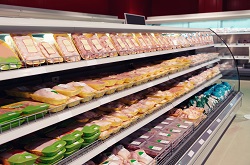Ensuring the quality of chicken meat produced in the EU
Chicken meat that has been removed from the bones by a machine must be labelled as ‘mechanically deboned’ under EU rules. However, this label pushes down the price of meat, holding back the competitiveness of the sector. EU-funded project MEAQUAS aimed to boost the competitiveness of chicken meat produced in the EU with innovative tools to assess the quality of mechanically deboned meat. This will allow high quality mechanically deboned meat produced in the EU to be identified and compared to lower quality mechanically deboned meat which is often imported from outside the EU. ‘MEAQUAS aims to become the new industry standard for the quality of meat removed by machine, boosting the competitiveness of the EU’s meat industry which comprises around 25,000 companies working in the production of meat products,’ says Poul Erik Damkjær, MEAQUAS project coordinator. Project scientists have developed a new method to automatically analyse and grade the meat using novel staining markers that highlight muscular structures. The software then uses image processing algorithms to quantify the degree of degradation in the meat. MEAQUAS’ technology quantifies the loss of structural integrity in the chicken meat, a key indicator of the meat’s quality and a way of proving that mechanically deboned meat is of the same quality as hand-removed meat. MEAQUAS hopes that regulatory bodies will define criteria for different meat qualities using the results of the project’s measuring technology. Ultimately, quality screening will enable high quality mechanically deboned meat to be labelled simply as ‘chicken meat’, improving its market value. Whole chickens to chicken pieces A few decades ago, chicken was widely sold as a whole chicken. However, from the 1990s chicken parts started being sold separately as thighs, breasts and wings. After separating the bird, small parts of the chicken are left over – known as the trimmings – which can be used for minced meat products. These parts are made from muscle which is high quality meat. However, the meat from the trimmings is commonly separated using a machine to rub the meat off the bones. ‘During the 1980s, so-called food experts decided that this meat could only be of poor quality since it was removed mechanically,’ explains Damkjær. ‘In fact, they started a false campaign that led consumers to believe that entire chickens were being run through a mincing machine, giving the impression that mechanically removed meat contains bones, skin, feather remains, giblets, intestines etc,’ he adds. As a result, mechanically removed meat gained a poor reputation and began to be shunned by customers. Reflecting consumer concerns, new EU rules came into place that required products containing mechanically removed chicken to be labelled as Mechanically Deboned Meat (MDM), while products containing chicken trimmings removed by hand could be labelled as simply as chicken meat. Today, mechanically deboned chicken has a value of around EUR 0.60 – EUR 0.90 per kilogram, while hand-boned trimmings are worth EUR 1.60 – EUR 2.80 per kg because they can be labelled as ‘meat’. If products produced by machine could be labelled to reflect the quality, meat could be sold at a higher price benefitting the meat sector. The project focussed on chicken meat, but test runs of the technology on different meat – pork and turkey – were positive. With some fine tuning, the staining techniques developed by MEAQUAS can be adapted to most animal species, potentially becoming of enormous benefit to the EU’s slaughter industry.
Keywords
MEAQUAS, chicken meat, mechanically deboned, staining technology, quality meat



